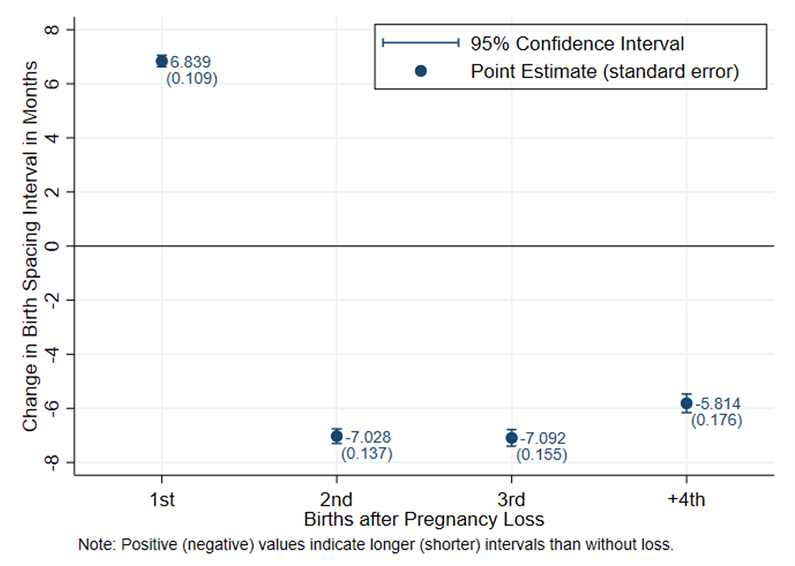IDE Research Columns
Column
‘Don’t Hurry, Haste Makes Waste’ But Why Do We Still Do? A Case from a Behavioural Analysis of Birth Spacing in Sub-Saharan Africa

Masaru NAGASHIMA
Institute of Developing Economies, JETRO
March 2024
Birth spacing is essential for the physical health and socioeconomic outcomes of children and mothers. This study demonstrates that an experience of pregnancy loss, including miscarriage and stillbirth, can affect fertility behaviour and significantly shorten spacing intervals throughout the reproductive period. This study hypothesises that such a behavioural response is caused by a change in the probabilistic belief—how likely the mother perceives she is to lose a pregnancy—based on her fertility history and finds consistent results with the theoretical predictions. This study builds on a unique combination of several strands of literature to develop analytical frameworks. The results suggest that pregnancy loss can be a behavioural risk factor for maternal and infant health in high-fertility settings such as sub-Saharan Africa.
Birth Spacing Behaviour in Sub-Saharan Africa
Sub-Saharan Africa (SSA) is characterised by high fertility and high mortality of mothers and infants. Naturally linked to these factors is short birth spacing, which is considered a risk factor for physical health and socioeconomic outcomes. Previous studies have associated birth spacing with infant mortality, preterm delivery, and pregnancy-related complications (e.g., Conde-Agudelo, Rosas-Bermúdez, and Kafury-Goeta 2006). It has also been demonstrated to affect children’s education, health, marriage outcomes, and mothers’ wages (e.g., Buckles and Munnich 2012; Karimi 2014). However, little has been investigated about the decision-making process in birth spacing. Factors that shorten spacing intervals are particularly poorly understood despite their utmost relevance in SSA.
Among many potential determinants, this study focused on the experience of pregnancy loss, such as miscarriage or stillbirth. A related event, infant mortality, is shown to shorten subsequent birth spacing (e.g., Bhalotra and van Soest 2008). However, infant mortality typically decreases as economies grow and health services improve. On the contrary, pregnancy loss is primarily caused by genetic anomalies (discussed subsequently) and is thus unlikely to decrease with economic status. Furthermore, existing studies on the impacts of pregnancy loss on birth spacing behaviour have used data from richer countries. However, empirical evidence is likely more valuable in less developed countries with higher fertility rates.
Belief Updating Mechanisms for Birth Spacing Decisions
How is pregnancy loss linked to birth spacing behaviour? This study considers a model incorporating a belief updating mechanism. The model assumes that a woman is reproductive for a fixed period, and she decides when to time pregnancies to achieve her desired number of children. She faces the risk of losing every pregnancy, but she does not know its true probability. In such a situation, she forms a probabilistic belief, her personal notion of the likelihood that she will lose a pregnancy, to guide herself in fertility timing decisions. The model predicts that she will try to become pregnant earlier if she believes she has a high chance of pregnancy loss.
Now, the model is set, but the question is: Where does the belief come from? Is it innate to a person or based on social norms? Several studies in behavioural science show that one’s own experience can be a crucial factor influencing the formation of probabilistic beliefs (e.g., Hertwig et al. 2004). That is, a woman has zero experience of pregnancy loss when she becomes reproductive for the first time, which means she is likely to possess a belief of very low pregnancy loss probability. She is expected to maintain this low-probability belief or lower it further with every successful pregnancy. However, she might end up losing a pregnancy at some point, which can be a tragic event for her. She may respond to it in various ways, one of which would be that she starts to believe in an increased risk of pregnancy loss. How would the updated probabilistic belief affect her reproductive decisions? The model implies that she would attempt to get pregnant earlier, resulting in shorter birth spacing intervals.
Empirical Analysis and Findings from Data
This study analyses the reproductive behavioural response to pregnancy loss using Demographic and Health Surveys (DHS) data from SSA countries. The surveys interviewed women aged 15–49 years and collected detailed information about their demographic characteristics, socioeconomic status and reproductive activities. The data collected include fertility history and experience of pregnancy loss. The study compiles a data set of approximately 2 million births for 500,000 women in 33 countries from 1998 through 2018. The data show that the average birth spacing interval is 34.4 months, and 42.2% of birth intervals are shorter than the World Health Organization recommends.
A simple comparison of women with and without pregnancy loss experience can be problematic since the two types of women may differ in their fertility behaviours regardless of the experience. The same is true for comparing birth intervals before and after the loss experience since other changes in fertility behaviours may occur simultaneously. This study addresses these issues by first reviewing the literature on obstetrics and gynaecology and identifying the causes of miscarriage, the most dominant type of pregnancy loss. It finds that 50%–80% of miscarriages are caused by genetic abnormalities in the fertile egg, which is more likely to occur in older women but otherwise considered unexplained by known factors. The literature review also identifies several other risk factors, such as physical attributes and exposure to infectious diseases. In other words, after controlling for these known risk factors, pregnancy loss can be regarded as a random event. This finding is incorporated into the econometric analysis to estimate the change in birth spacing intervals before and after pregnancy loss among women who have experienced pregnancy loss. The estimation results can thus be interpreted as a causal impact of pregnancy loss.
The results of the analysis are twofold. First, the birth spacing interval changes considerably after a pregnancy loss (Figure 1). The first post-loss birth has a longer spacing interval, whereas all subsequent births have a shorter interval. The lengthening effect can be mechanical because birth intervals are measured as the period between current and previous live births. That is, the birth interval includes the period between the birth of the last pre-loss pregnancy and the loss and the period between the loss and the birth of the first post-loss pregnancy. The novel finding in this study is the shortening effect for all subsequent births, which is found to dissipate slightly over time but never disappear. This finding is consistent with the model prediction and is particularly insightful for SSA, where mothers tend to undergo several pregnancies even after a loss.
Second, the belief updating mechanism is likely at play. The DHS data do not contain the survey participants’ past beliefs on pregnancy loss probability. Thus, the study constructs a proxy variable for the belief: the proportion of lost pregnancies out of all pregnancies at the conception of each pregnancy. The analysis using the thus-defined proxy finds that the persistent shortening effect is not due to the mere fact that the remaining reproductive period is shortened by the lost pregnancy but is likely to result from the change in probabilistic belief.

Figure 1 Change in Birth Spacing Interval
Source: Author based on Nagashima and Yamauchi (2023).
Implications for Further Studies and Policies
The study shows that pregnancy loss can impact the entire subsequent reproductive behaviour through shortened birth intervals. This is a unique contribution to the literature on the determinants of fertility behaviour in SSA, where the finding is especially valuable because of high fertility rates. The findings also indicate the involvement of a behavioural mechanism in the impact of pregnancy loss on birth spacing. These results are obtained by combining different strands of literature and help enrich our understanding of human behaviours. In particular, the behavioural response to belief updating triggered by experiences of stochastic events can have implications for broader literature than just fertility.
A critical policy lesson can be drawn from this study. That is, an information intervention to provide consultation to mothers who have just lost a pregnancy may help reduce the potential harm of the behavioural response. This is because the belief updating response tends to be volatile, creating a sudden big change, and takes a long time to converge to the scientifically known level. Expert consultation may play another important role because pregnancy loss can be a traumatic and tragic event in itself that can affect birth spacing without necessarily affecting probabilistic belief soon after the loss. It is thus an interesting next step to investigate the efficacy of information dissemination in the context of SSA.
Author’s Note
This column is based on Nagashima, Masaru, and Chikako Yamauchi. 2023. ‘Pregnant in Haste? The Impact of Foetus Loss on Birth Spacing and the Role of Subjective Probabilistic Beliefs’. Review of Economics of the Household 21(4) : 1409–31. https://doi.org/10.1007/s11150-023-09664-8.
References
Bhalotra, Sonia, and Arthur van Soest. 2008. ‘Birth-Spacing, Fertility and Neonatal Mortality in India: Dynamics, Frailty, and Fecundity’. Journal of Econometrics 143 (2): 274–90.
Buckles, Kasey S., and Elizabeth L. Munnich. 2012. ‘Birth Spacing and Sibling Outcomes’. Journal of Human Resources 47 (3): 613–42.
Conde-Agudelo, Agustin, Anyeli Rosas-Bermúdez, and Ana Cecilia Kafury-Goeta. 2006. ‘Birth Spacing and Risk of Adverse Perinatal Outcomes: A Meta-Analysis’. Journal of American Medical Association 295 (15): 1809–23.
Hertwig, Ralph, Greg Barron, Elke U. Weber, and Ido Erev. 2004. ‘Decisions from Experience and the Effect of Rare Events in Risky Choice’. Psychological Science 15 (8): 534–39.
Karimi, Arizo. 2014. ‘The Spacing of Births and Women’s Subsequent Earnings: Evidence from a Natural Experiment’. IFAU Working Paper no. 2014:18. Uppsala: Institute for Evaluation of Labour Market and Education Policy.
* Thumbnail image: African woman sitting with her baby, Kenya, East Africa (hadynyah/ E+/ Getty Images)
** The views expressed in the columns are those of the author(s) and do not represent the views of IDE-JETRO or the institutions with which the authors are affiliated.

